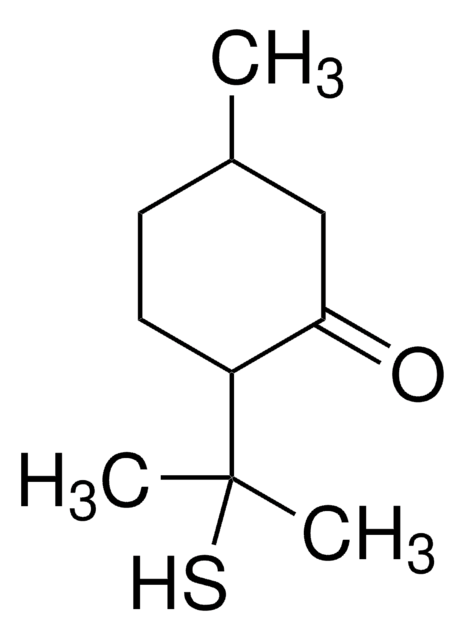W243906
Ethyl hexanoate
≥98%, FCC, FG
Sinónimos:
Caproic acid ethyl ester, Ethyl caproate
About This Item
Productos recomendados
origen biológico
synthetic
Nivel de calidad
grado
FG
Halal
Kosher
Agency
meets purity specifications of JECFA
cumplimiento norm.
EU Regulation 1334/2008 & 178/2002
FCC
FDA 21 CFR 117
FDA 21 CFR 172.515
densidad de vapor
5 (vs air)
Análisis
≥98%
índice de refracción
n20/D 1.407 (lit.)
bp
168 °C (lit.)
densidad
0.869 g/mL at 25 °C (lit.)
aplicaciones
flavors and fragrances
Documentación
see Safety & Documentation for available documents
alérgeno alimentario
no known allergens
Organoléptico
banana; green; waxy; fruity; pineapple; sweet
cadena SMILES
CCCCCC(=O)OCC
InChI
1S/C8H16O2/c1-3-5-6-7-8(9)10-4-2/h3-7H2,1-2H3
Clave InChI
SHZIWNPUGXLXDT-UHFFFAOYSA-N
¿Está buscando productos similares? Visita Guía de comparación de productos
Descripción general
Aplicación
- Formation of Key Aroma Compounds During 30 Weeks of Ripening in Gouda-Type Cheese Produced from Pasteurized and Raw Milk.: The study investigates the formation of key aroma compounds, including ethyl hexanoate, during the ripening of Gouda-type cheese. The results provide insights into the ripening process and its impact on cheese flavor development (Duensing et al., 2024).
Palabra de señalización
Warning
Frases de peligro
Consejos de prudencia
Clasificaciones de peligro
Flam. Liq. 3
Código de clase de almacenamiento
3 - Flammable liquids
Clase de riesgo para el agua (WGK)
WGK 1
Punto de inflamabilidad (°F)
127.4 °F - closed cup
Punto de inflamabilidad (°C)
53 °C - closed cup
Equipo de protección personal
Eyeshields, Faceshields, Gloves, type ABEK (EN14387) respirator filter
Elija entre una de las versiones más recientes:
¿Ya tiene este producto?
Encuentre la documentación para los productos que ha comprado recientemente en la Biblioteca de documentos.
Los clientes también vieron
Nuestro equipo de científicos tiene experiencia en todas las áreas de investigación: Ciencias de la vida, Ciencia de los materiales, Síntesis química, Cromatografía, Analítica y muchas otras.
Póngase en contacto con el Servicio técnico












